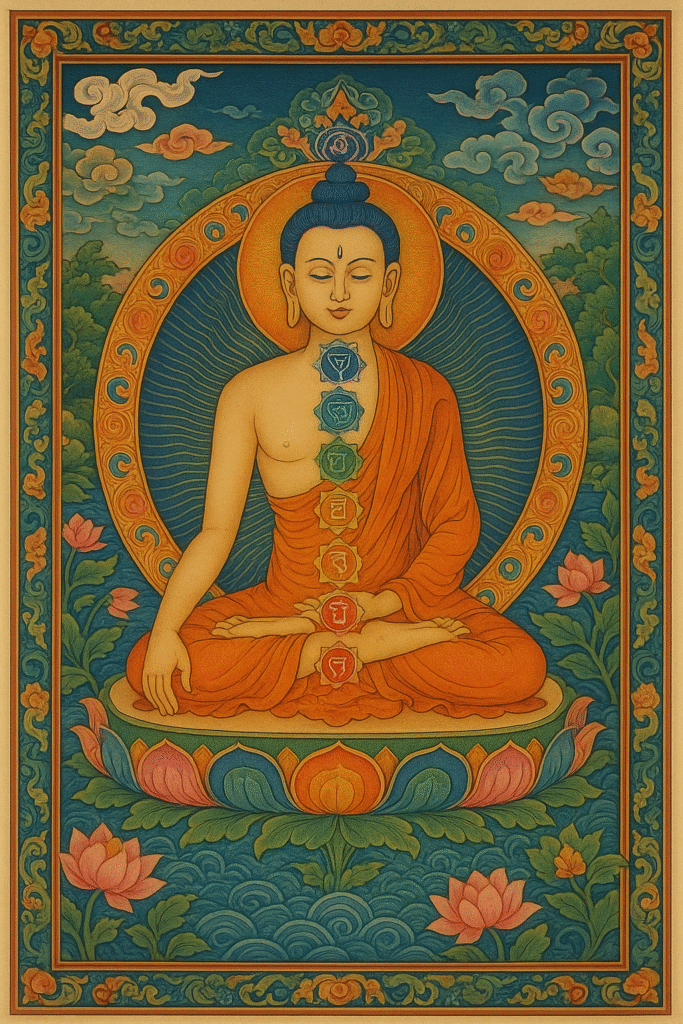Introduction to Kundalini Symbols
At its heart, kundalini represents sacred feminine energy that lies sleeping at the base of your spine. Picture a coiled serpent, resting in what’s known as the muladhara chakra – this is how ancient texts describe this powerful spiritual force.

You might wonder where this concept came from. The story begins in ancient India, where sacred texts called the Upanishads first mentioned Kundalini symbols, which were everywhere between 800 BCE and 400 BCE. These writings tell us about awakening this dormant energy and its journey up through the body’s central channel.
The serpent symbol isn’t just a random choice – it perfectly shows how kundalini energy works. When you look at traditional artwork, you’ll see it wrapped three and a half times at the spine’s base. This image helps you grasp both its quiet, waiting nature and its potential to rise up through your body’s energy centers.
Think of these symbols as your roadmap for understanding kundalini. They’re like visual guides that make complex spiritual ideas easier to understand and work with during meditation and practice.
Key Kundalini Symbols and Their Meanings
When you look at kundalini artwork, you’ll notice the serpent isn’t alone – it’s often joined by other meaningful symbols. The Caduceus shows two snakes winding around a central staff, matching how energy flows through your body’s main channels. This symbol speaks to the balance of opposing forces within you.

The Double Circle brings another layer of meaning – it shows the coming together of opposite energies, often called the sacred marriage. Think of it as the meeting point between your physical and spiritual self.
The Triangle points upward, showing the rising of kundalini energy, while the Vesica Piscis (two overlapping circles) represents the merging of different energy states. The Flail symbol shows movement and activation – just like the whip-like motion of kundalini symbols rising through your chakras.
These symbols aren’t just pretty pictures – they’re tools for your practice. When you meditate with them, they help you connect with and channel kundalini energy, making your spiritual work more focused and meaningful.
Chakra System and Symbols
The seven chakras form the heart of kundalini yoga – they’re like energy stations lined up along your spine. Starting at the base where kundalini sleeps, each chakra tells its own story through unique symbols and colors.
Let’s look at these energy centers: The root chakra shows up as a red, four-petaled lotus. Above it, the sacral chakra glows orange with six petals. Your solar plexus chakra shines yellow, sporting ten petals. The heart chakra blooms green with twelve petals, while your throat chakra sparkles blue with sixteen. Your third eye chakra glows indigo with two petals, and finally, your crown chakra radiates violet with a thousand petals.
As kundalini energy moves up through each chakra, you might notice changes in your body and mind. The chakra symbols and meaning help you focus during meditation – imagine them like signposts guiding you through the awakening process. When you work with these symbols, they become powerful tools for your spiritual practice.
Practical Applications for Modern Practitioners
Want to work with kundalini symbols in your daily practice? Start with simple meditation. Sit quietly and picture the coiled serpent at the base of your spine. As you breathe deeply, imagine it slowly waking up and moving upward through each chakra.
For visualization, try this: Close your eyes and see the serpent glowing with golden light. Feel its warmth spreading from your tailbone up through your body. Women might connect more strongly with moon imagery, while men often relate better to sun symbols during this practice.
Here’s how to bring these symbols into your everyday routine:
- Draw kundalini symbols in your journal before morning meditation
- Place chakra artwork in your meditation space
- Wear jewelry featuring serpent designs
- Set your phone background to your chosen symbol
- Take short breaks to trace the symbol paths with your finger
Remember to take it slow – kundalini energy is powerful stuff. Working with a teacher who knows these practices can help you stay safe and centered as you grow.
Cultural and Cross-Traditional Perspectives
In Eastern spiritual practice, the serpent image carries deep meaning – it’s woven into the fabric of Hindu and Buddhist teachings. You’ll find it in ancient temples, sacred texts, and spiritual art, always pointing to the power of kundalini shakti.
The serpent shows up in Western traditions too, but you might not spot it right away. Look at the staff of Hermes in Greek mythology or the snake in the Garden of Eden story – these images hint at hidden spiritual knowledge and transformation, much like kundalini energy.
What’s fascinating is how these snake symbols pop up everywhere – from Native American wisdom to African tribal art. They all seem to tell the same story: there’s a sleeping power inside us waiting to wake up.
Think about the rod of Asclepius in medicine or the ouroboros (the snake eating its tail) in alchemy. These symbols speak to something universal about human spiritual growth. Whether you’re studying Eastern yoga or Western mysticism, you’ll find these cultural perspectives on spirituality described in surprisingly similar ways.
Embracing the Sacred Language of Kundalini
As you dive deeper into the world of kundalini symbols, you’ll discover they’re more than ancient drawings – they’re keys to understanding your own spiritual journey. Each symbol, from the coiled serpent to the intricate chakra designs, offers a unique window into the mysteries of consciousness and transformation.
Remember, these sacred symbols have guided seekers for thousands of years, and they’re still relevant today. Whether you’re new to spiritual practice or a seasoned practitioner, letting these symbols speak to you can enhance your journey of self-discovery and awakening.
